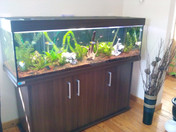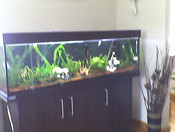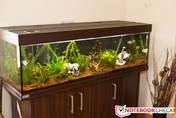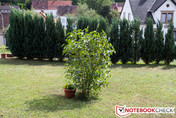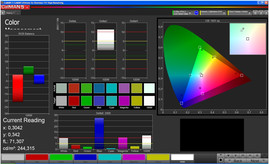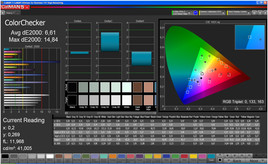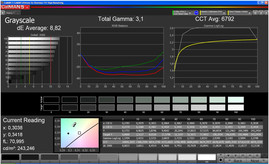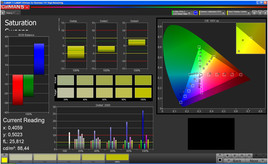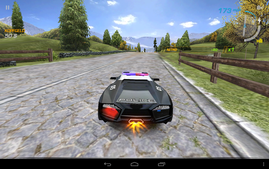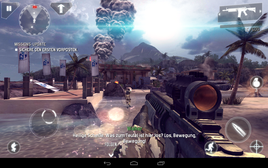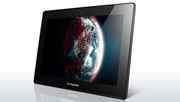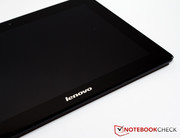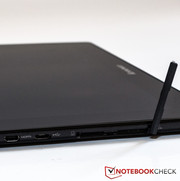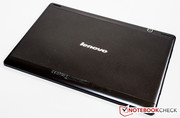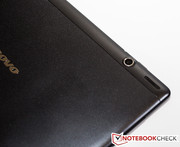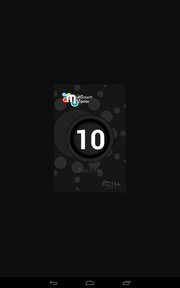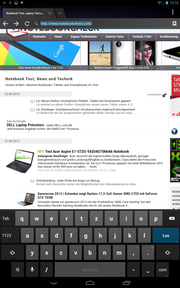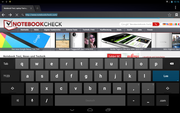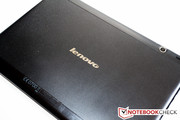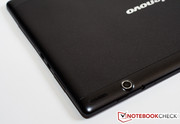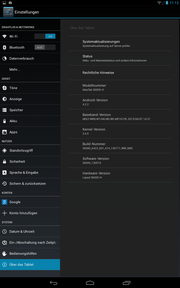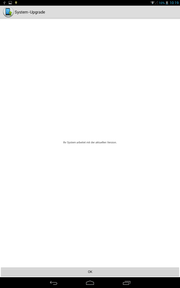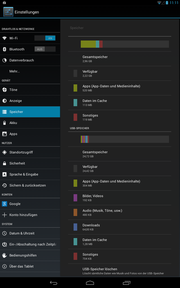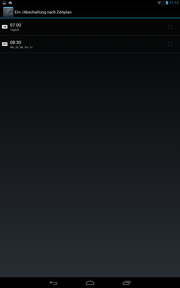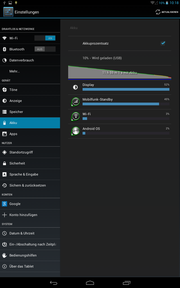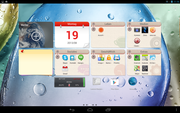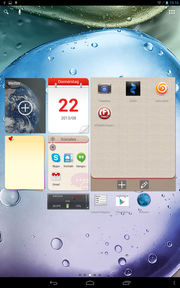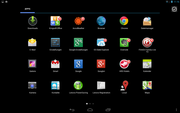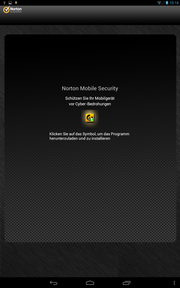Review Lenovo IdeaTab S6000 Tablet
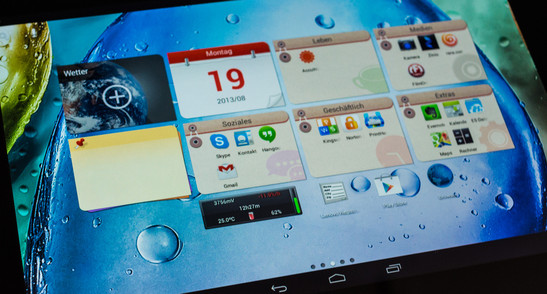
For the original German review, see here.
Lenovo added the IdeaTab S6000 to its lower mid-range models. Customers get a 10.1-inch IPS display and a quad-core SoC with a clock rate of 1.2 GHz for an RRP of 299 Euros (~$395). In addition, it features a 3G module, which allows access to the Internet outside of your local WLAN network. Thanks to the microSD slot, the built-in 32 GB memory can be easily enhanced and an up-to-date operating system is included with Android 4.2.2.
This review clarifies whether the price is justified and if there are interesting competitors.
Case
The attractive Lenovo IdeaTab is completely made from plastic. The rear side is divided into two segments. Matte polycarbonate is used on the upper and the lower edge and the plastic around the manufacturer's logo has a texture and a slightly different color. The tablet makes a quiet noise from side-to-side twisting and the rear cover can be marginally depressed. Overall, the build quality appears to be solid anyway.
With a size of 259.1 x 180.3 x 7.6 mm (~10.2 x 7.1 x 0.3 inches) the IdeaTab is similar to the Toshiba eXcite Pro in length and width, yet significantly lower (eXcite Pro: 10.5 mm/~0.4 inches). The weight of 562 grams (~1.2 pounds) is average for a 10-inch tablet.
Connectivity
The connectivity is surprisingly good for a tablet with an RRP of 299 Euros (~$395). The IdeaTab comes with the usual interfaces including a microUSB slot for charging or connecting to a computer, a 3.5 mm audio port and a microSD slot for expanding the memory. In addition, it features a micro-HDMI port, which allows displaying on a TV. With the SIM slot, you can connect to the mobile Internet outside of your local WLAN. Thanks to the memory card slot, you can add a further 64 GB to the built-in 32 GB.
Telephone functions
Although you can insert a SIM card into the IdeaTab S6000, there is no telephone app preinstalled. If you select a number from your address book, you can only contact it via Skype or another VoIP service. The new Samsung Galaxy Tab 3 10.1 has an integrated telephone function, which works flawlessly.
Software
Potential buyers of the IdeaTab S6000 must do with the second to last version of Google's operating system, release number 4.2.2. It reminds us of the original devices of the Nexus series. User interface and system settings have been slightly modified. Lenovo added bloatware including apps like "Norton Mobile" or "Lenovo PowerSaving", which can easily be uninstalled.
Communication & GPS
The tablet can connect to the Internet via a Wi-Fi hotspot with standards 802.11 b/g/n. It lacks a dual band module. If you cannot connect via a local network, you can do so with a SIM card. Given a contract with a service provider, data can be downloaded to the device with a maximum transfer rate of 42.2 Mbit/s. It is not compatible with the LTE radio network. In the vicinity, data can be transferred via Bluetooth 4.0 and the DLNA network standard is used if needed.
Being equipped with a GPS module, the tablet can be used as a mobile navigation solution. Inside rooms, it is difficult to establish a stable connection to a satellite. This problem will resolve as soon as "line of sight" is established. While it was, we could not observe any significant interruptions.
Cameras & Multimedia
The test sample features two camera modules. The front sensor only has a resolution of 0.3 MP and is mainly used for video telephony. Snapshots can be taken with the 5 MP main camera.
Pictures taken outdoors with the main camera have a good quality. Colors are realistic and close to the reference camera's. Meanwhile, the pictures of the front camera are hardly usable, as they are very blurred. Our indoor picture was taken in a very bright room with many windows. Nevertheless, dark parts of the pictures are noisy and as a result, the pictures look blurry. The front camera performs even worse indoors and is completely useless.
Accessories & warranty
There is nothing in the box apart from a modular power adaptor and several quick guides. A Bluetooth keyboard is optionally available. It can be attached to the tablet with a magnet.
The warranty period of the device and the battery is 12 months. Warranty is handled via a courier or depot service. Further information is available on the manufacturer's web site.
Input devices and handling
Unfortunately, we could not test the Bluetooth keyboard. Therefore, we tested the virtual input devices in-depth. The screen reacts precisely and is responsive. However, there is a delay when rotating the display. Apparently the sensor is somewhat slow.
The standard keyboard has an usual layout and left a good impression. In portrait mode, it occupies 30% of the display area, thus, the background picture can be recognized. This changes in landscape mode; 50% of the space is occupied leaving the display cramped.
Display
The IdeaTab uses a capacitive display with a resolution of 1280x800 pixels, while the 3-inch smaller Nexus 7 2013 features Full HD resolution, which would also be highly appreciated in our test sample. The IPS screen of our test device has a pixel density of 149 ppi - This is exactly the same as the Samsung Galaxy Tab 3 10.1's. Meanwhile, the Toshiba eXcite can score points with double the pixel density.
According to the manufacturer's web site the display achieves a brightness of 350 cd/m² (they did not specify whether this is the average or the maximum brightness). We checked whether this is actually true with the X-Rite i1Pro 2. However, our values differ greatly from the manufacturer's. We recorded a maximum of 283 cd/m² and an average brightness of 253.1 cd/m² and the distribution of brightness is only 78%. The new Galaxy Tab 3 8.0 achieves an 92% and has a significantly brighter screen. The black value of 0.37 cd/m² is satisfactory and the resulting contrast of 714:1 is acceptable and at least significantly higher than the Galaxy Tab 3 10.1's (606:1).
| |||||||||||||||||||||||||
Brightness Distribution: 78 %
Center on Battery: 283 cd/m²
Contrast: 714:1 (Black: 0.37 cd/m²)
ΔE ColorChecker Calman: 6.61 | ∀{0.5-29.43 Ø4.79}
ΔE Greyscale Calman: 8.82 | ∀{0.09-98 Ø5}
Gamma: 3.1
CCT: 6792 K
The display of the IdeaTab S6000 performs poorly outdoors. The average brightness should be significantly higher and the black value should be lower. However, the result is still just passable, if you adapt the viewing angle and do not use the tablet under direct sunlight.
Performance
The IdeaTab features a quad-core Cortex A7 with a clock rate of 1.2 GHz. The SoC from Mediatek is called MT8389 and is supported by a PowerVR Series5XT. The Cortex A7 is the successor of the older Cortex A8 and is often used in ARM's big.LITTLE concept. SoCs of this kind are said to be very frugal in terms of power consumption. CPU and GPU have 1 GB of RAM available.
In the synthetic benchmarks including "Geekbench 2", "PassMark Performance Test", and "AndEBench", our test devices performs better than the Galaxy Tab 3 8.0. However, the IdeaTab S6000 does not stand a chance against competitors with faster hardware, e.g., the Toshiba eXcite Pro or the Google Nexus 10.
| Geekbench 2 - 32 Bit - Total Score (sort by value) | |
| Lenovo IdeaTab S6000 | |
| Samsung Galaxy Tab 3 8.0 SM-T310 | |
| Samsung Galaxy Tab 3 10.1 | |
| Toshiba eXcite Pro AT10LE-A-108 | |
| Google Nexus 7 2013 | |
| Google Nexus 10 | |
| PassMark PerformanceTest Mobile V1 - System (sort by value) | |
| Lenovo IdeaTab S6000 | |
| Samsung Galaxy Tab 3 8.0 SM-T310 | |
| Samsung Galaxy Tab 3 10.1 | |
| Toshiba eXcite Pro AT10LE-A-108 | |
| Google Nexus 7 2013 | |
The result of the browser-based performance tests is unambiguous. Our test sample performs much worse than the competition, which is up to +253% faster in Google's Octane V1.
This result should not be misinterpreted. Even if the competitors perform better, this does not mean that the IdeaTab S6000 is extremely slow in browser applications. It is difficult to feel the difference.
| Browsermark - --- (sort by value) | |
| Lenovo IdeaTab S6000 | |
| Samsung Galaxy Tab 3 10.1 | |
| Toshiba eXcite Pro AT10LE-A-108 | |
| Google Nexus 7 2013 | |
| Google Nexus 10 | |
| Octane V1 - Total Score (sort by value) | |
| Lenovo IdeaTab S6000 | |
| Samsung Galaxy Tab 3 10.1 | |
| Samsung Galaxy Tab 3 8.0 SM-T310 | |
| Toshiba eXcite Pro AT10LE-A-108 | |
| Google Nexus 7 2013 | |
| Peacekeeper - --- (sort by value) | |
| Lenovo IdeaTab S6000 | |
| Samsung Galaxy Tab 3 10.1 | |
| Samsung Galaxy Tab 3 8.0 SM-T310 | |
| Toshiba eXcite Pro AT10LE-A-108 | |
| Google Nexus 7 2013 | |
| Google Nexus 10 | |
| Mozilla Kraken 1.0 - Total (sort by value) | |
| Lenovo IdeaTab S6000 | |
| Samsung Galaxy Tab 3 10.1 | |
| Samsung Galaxy Tab 3 8.0 SM-T310 | |
| Google Nexus 7 2013 | |
| Sunspider - 0.9.1 Total Score (sort by value) | |
| Lenovo IdeaTab S6000 | |
| Samsung Galaxy Tab 3 10.1 | |
| Toshiba eXcite Pro AT10LE-A-108 | |
| Google Nexus 7 2013 | |
| Google Nexus 10 | |
* ... smaller is better
The result of the flash memory is a mixed bag. In sequential reading, our test device is slower than all competitors in all tests. However, it performs quite well in random reading. Only the new Google Nexus 7 is faster here.
Videos & Games
The quad-core SoC is sufficient for watching our Full HD trailers. All MKV files can be played with the preinstalled players and loading is not delayed. The maximum data rate of the sequences is about 6100 kBit/s.
With "GTA III", "Need for Speed: Hot Pursuit" and "Modern Combat 4", we checked whether 3D games run without problems. The hardware can also handle these, but we doubt that it also could in Full HD. Maybe this is why Lenovo decided against incorporating a high-resolution display.
Emissions
Temperature
When comparing the idle and the load temperatures it gets apparent that they hardly differ. The temperature only rarely exceeds 30 °C (86 Fahrenheit) under full load. The power adaptor also remains relatively cool under load. The results of our temperature measurements are absolutely convincing.
(+) The maximum temperature on the upper side is 33.6 °C / 92 F, compared to the average of 33.7 °C / 93 F, ranging from 20.7 to 53.2 °C for the class Tablet.
(+) The bottom heats up to a maximum of 33.3 °C / 92 F, compared to the average of 33.2 °C / 92 F
(+) In idle usage, the average temperature for the upper side is 29.1 °C / 84 F, compared to the device average of 30 °C / 86 F.
Speakers
The two speakers are on the top part of the rear side, thus they are covered as soon as the tablet sits on a flat surface. As a result, the sound is distorted. Between 60% and 100% of the maximum volume, you can hardly hear if the volume is increased. However, this is not a concern, as you should avoid loud volumes anyway. High tones are slightly distorted, sound tinny and are unpleasantly loud. The ears will start to ache after a few minutes.
Energy Management
Power Consumption
The power consumption of the IdeaTab S6000 (23 Wh) is low compared to other tablets. It just needs between 4.3 and 4.8 Watts under load. The Toshiba eXcite's power consumption is about twice as high (9.3 to 13.2 Watts) and also the Galaxy Tab 3 8.0 requires more energy. If the load is lower, the power consumption decreases to between 1.9 and 3.5 Watts. The device is also very frugal in this scenario while the Galaxy Tab 3 10.1 with the same size needs between 2.5 and 5.8 Watts.
| Off / Standby | |
| Idle | |
| Load |
|
Key:
min: | |
Battery Life
Our tablet surprises us in our first scenario. 5 hours 47 minutes under full load are seldom reached and even the iPad 4 from Apple cannot keep up (battery life of 04:12 hours). The IdeaTab profits from its low power consumption. The WLAN test ends after 08:44 hours, as the power consumption is only slightly lower than under load. The difference in the idle scenario is bigger, as the display is dimmed and all wireless modules are deactivated. 16 hours and 8 minutes is a decent result. The Toshiba eXcite Pro can only dream of such results.
Verdict
In the previous weeks, we used the IdeaTab S6000 every day and it left a good impression. The 10-inch tablet features the usual wireless modules (Bluetooth, Wi-Fi, GPS) and a 3G module for mobile Internet. The capacity of the internal memory of 32 GB is sufficient and a slot for microSD cards is available. The battery life cannot be criticized in any way and the tablet achieves a very good battery life in demanding scenarios.
However, we have to criticize the central user interface - the capacitive IPS display. Because of a brightness of only 253.1 cd/m², its outdoor capabilities are limited when the sky is not overcast. The resolution of 1280x800 pixels is all right for the price, but a Full HD display would have been great. The SoC from Mediatek cannot achieve excellent results in our benchmarks, but it can run all tests without problems. Those looking for a solid tablet for everyday tasks with a long battery life and 3G module for below 300 Euros (~$396) should take a closer look at the Lenovo IdeaTab S6000.











